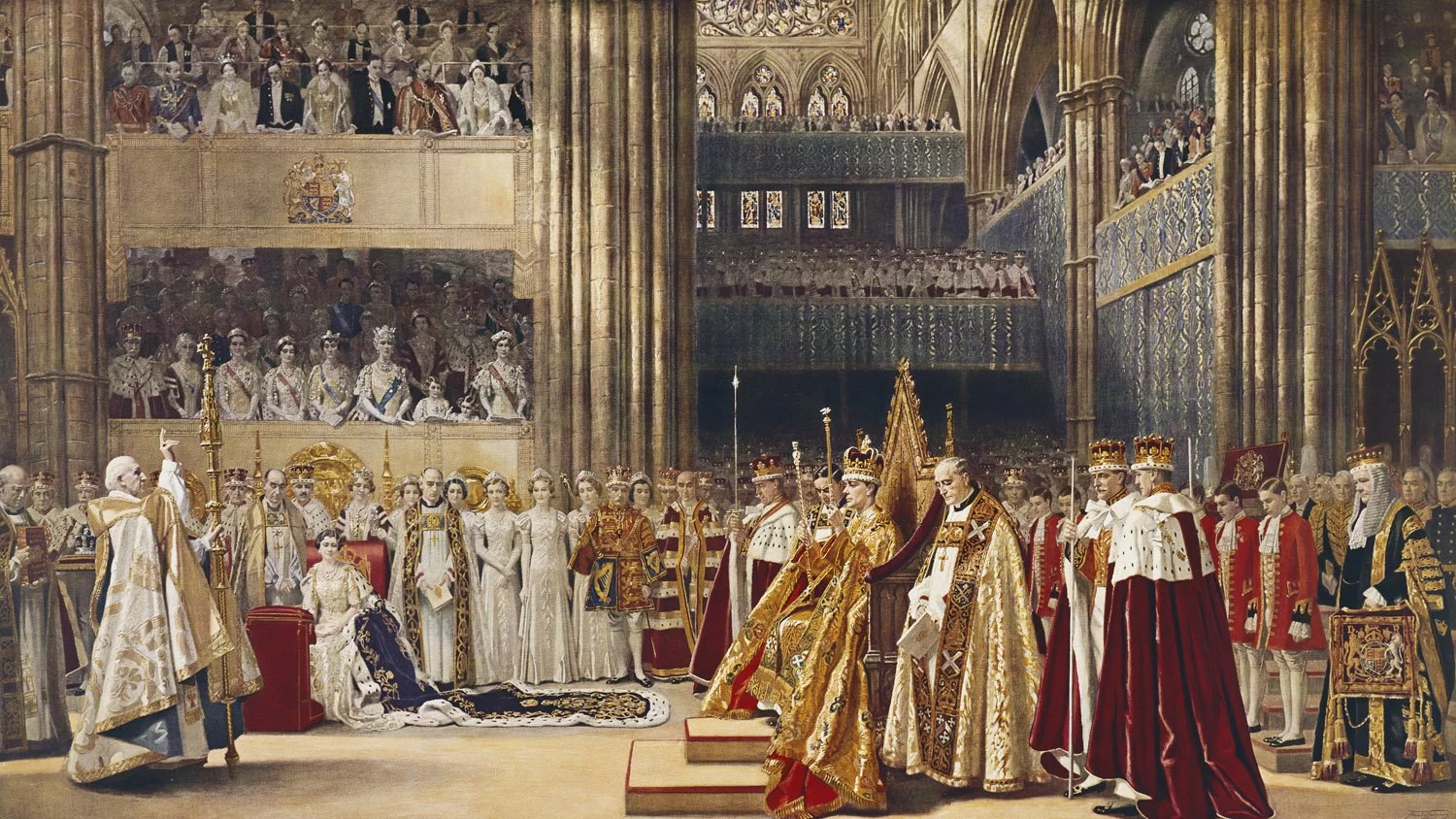
The Ceremony
A page detailing the elements of the Coronation ceremony
Introduction
The fanfare of trumpets which echoed across the courtyard at St James’s Palace on 10th September 2022, following the Proclamation of His Majesty King Charles III, will sound again on Coronation Day, 6th May 2023, in Westminster Abbey.
For nine hundred years this historic building has been the scene of coronations of British Kings and Queens, first in the great church built by Edward the Confessor, and then in the present Abbey Church which Henry III built on the same site in the 13th century. The Coronation Service, too, has changed little for nearly twelve hundred years except that English has taken the place of Latin, but in essentials it remains the same. It is still a service of elation, of confirmation of the people’s choice, and of consecration and dedication of the Sovereign to the service of God and to his people throughout the British Isles and the Commonwealth. Not only is the Coronation a solemn covenant between the King and his people but it is also, on their part, a sign of loyalty in return.
Westminster Abbey with a procession of the Knights of the Bath by Canaletto
This momentous and historic occasion which is probably the most colourful, glittering and impressive ceremony in the world is not, however, a mere pageant of history. All the symbolic rites included in the ceremony are of a deeply spiritual significance and the Coronation Service throughout implies that the life of the Monarch is a life dedicated to the service of God and man.
The very heart of the ceremony is not the crowning, but the anointing. This is done by the Archbishop of Canterbury who pours the holy oil from the Ampulla, a vessel of gold in the shape of an eagle, into the 12th-century richly ornamented Anointing Spoon; he then removes the oil from the spoon and, in the form of a cross, he touches the Sovereign on the crown of his head, the breast and palms of both hands – an action signifying glory, holiness and fortitude.
Following the Anointing, the ceremony continues with the girding of the Sword, an indication of the placing of the Sovereign’s sword at the service of the Church; clothing with the Royal Robe; the presentation of the Orb, symbolising the dominion of the Christian religion over the world; and the presentation of the two sceptres, emblems of justice and mercy. All these, with the culminating act of Coronation, are filled with deep spiritual meaning which has remained constant down through the centuries.
At the conclusion of the Coronation Ceremony, the King, wearing his crown and arrayed in his coronation robe, will return to Buckingham Palace acknowledging the cheers of many thousands of people who will have gathered to see the brilliant pageantry of this most historic occasion. The centre-piece of this processional drive will be the resplendent State Coach, drawn by eight Windsor Greys, in which the King will ride with the Queen. Accompanying the Coach on either side will be the footmen, clad in red and gold; and the King’s Bodyguard of the Yeomen of the Guard in their picturesque Tudor uniforms. A Sovereign’s Escort of the Household Cavalry will add to the splendour of this glorious scene. The procession will be augmented by carriages carrying other members of the Royal Family.
Marching soldiers, sailors, airmen, bands, and crowds will contribute to a spectacle which only Britain can provide in Coronation Year, 2023.
The Ceremony
The Coronation Service itself is a series of ritual affirmations of the moral values necessary to a well-governed and good society. The key to the Coronation Service is the King’s promise to abide by the moral standards of society. The whole service reiterates their supremacy above the personality of the Sovereign. In his assurance that he will observe the canons of mercy, charity, justice and protective affection, he acknowledges and submits to their power. When he does this, he symbolically proclaims his community with his subjects who, in the ritual - and in the wider audience outside the Abbey - commit themselves to obedience within the society constituted by the moral rules which he has agreed to uphold.
This intricate series of affirmations is performed in the elaborate pattern which makes up the Coronation ceremony.
The Recognition
When the Archbishop presents the King to the four sides of the 'theatre', he is asking the assembly to reaffirm their allegiance to him not so much as an individual as the incumbent of an office of authority charged with moral responsibility and for which he has the preliminary qualifications of a blood-tie. The 'People' who signify their willingness to 'do homage and service' were once the actual members and representatives of the Estates whose participation was necessary for the security of the realm. Now, those within the Abbey, although many of great power stand among them, are no longer its exclusive possessors. The 'homage and service' of the entire society is far more important than it was in earlier Coronations and their offering is no more than a dramatic concentration of the devotion which millions now feel.
The Presentation of the Holy Bible
When the Moderator of the Church of Scotland presents the Holy Bible to the King, the Archbishop says that this act is performed in order to keep His Majesty 'ever mindful of the Law'. The Bible is a sacred object which contains in writing the fundamental moral teachings of the Christian society. Since this Bible is to go with him always, his moral consciousness is to be kept alive by means of continuous contact with the Book in which God's will is revealed. As the Moderator says, 'Here is Wisdom; This is the royal Law;" These are the lively Oracles of God.' The Bible which is handed to the King is not simply a closed and final promulgation of moral doctrine. It is the 'lively Oracles of God', in which moral inspiration and stimulus for the mastery of constantly emerging new events are to be found. The Bible is the vessel of God's intention, a source of continuous inspiration in the moral regulation of society.
The Oaths
The King is asked whether he will solemnly promise and swear to govern the people of the United Kingdom and the Realms and Territories in accordance with their respective laws and customs. When he does so, he clearly acknowledges that the moral standards embodied in the laws and customs are superior to his own personal will. The King agrees to respect justice and mercy in his judgments and to do his utmost to maintain the laws of God and the true profession of the Gospel. In doing this, he acknowledges once more the superiority of the transcendent moral standards and their divine source, and therewith the sacred character of the moral standards of British society. Apart from the momentary appearance of the Moderator of the General Assembly of the Church of Scotland, the Church of England administers the entire ceremony.
Britain is generally a Christian country in the broad sense, and in the Coronation Service, the Church of England serves the vague religiosity of the mass of the British people without raising issues of ecclesiastical jurisdiction or formal representation. As with so much else in the Coronation Service, behind the archaic facade, there is a vital sense of permanent contemporaneity.
The Anointing
When the King is divested of his regalia, he is presented as a frail creature who has now to be brought into contact with the divine, and thus transformed into a King, who will be something more and greater than the human being who has received the previous instruction. When the King sits in the saintly King Edward's Chair he is anointed by the Archbishop with consecrated oil which sanctifies him in his regal office. When he makes the cross on both his hands, his breast and the crown of his head, he places him in the tradition of the Kings of Israel and of all the rulers of England. He anoints him saying 'And as Solomon was anointed king by Zadok the priest and Nathan the prophet, so be thou anointed, blessed, and consecrated King over the Peoples.' It is not merely an analogy; it is a symbolisation of reality, in conformity with sacred precedent. He shows his submission before the Archbishop as God's agent, kneeling before him while he implores God to bless him.
The Investiture
The King is then told that he will be given the power to enforce the moral law of justice and to protect and encourage those whose lives are in accordance with the Law. He is asked to confirm what is in good order, and to restore to order what has fallen away from it. The sword is an instrument of destruction. It is as dangerous as the sacred foundations of the moral rules themselves and its terrible power, for evil, as well as good, must never be forgotten by the King. To stress this dual potentiality of authority, it is, throughout the rest of the ceremony, carried naked before him by the Lord President who redeemed it. In this way, the terrible responsibilities and powers of royal authority are communicated to the King and the people. The people are thus made aware of the protection which a good authority can offer them when they themselves adhere to the moral law, and of the wrathful punishment which will follow their deviation.
He is next invested with the bracelets of sincerity and wisdom and is dressed in the Royal Robes, which enfolds him in righteousness. With these dramatic actions, he is transformed into a vessel of the virtues which must flow through him into his society. Thus transformed, he is reminded of the wide sphere of his power, and of the responsibilities for its moral and pious use, by the Orb which he takes in his hand and places on the altar which is the repository of the most sacred objects. In doing this, he resanctifies his own authority. He is told to execute justice but never to forget mercy.
The Crowning
The Archbishop then blesses the Crown of St Edward, saying: “King of kings and Lord of lords, bless, we beseech thee, this Crown, and so sanctify thy servant Charles, upon whose head this day thou dost place it for a sign of royal majesty, that he may be crowned with thy gracious favour and filled with abundant grace and all princely virtues; through him who liveth and reigneth supreme over all things, one God, world without end. Amen.” The Dean takes the Crown from the velvet cushion on the High Altar and processes to the Theatre, where the Archbishop awaits beside King Edward’s Chair.
The Crown of St Edward, having been received from the Dean, is placed on the anointed head of the King to cries of “God Save The King!

